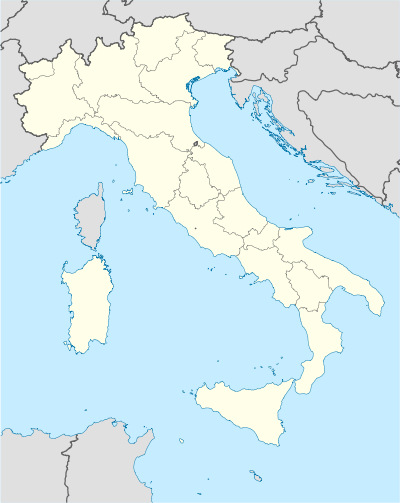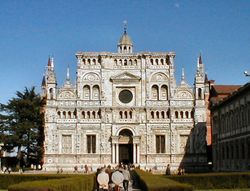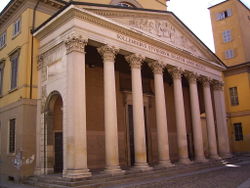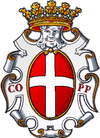Pavia
| Pavia | |||
|---|---|---|---|
| — Comune — | |||
| Città di Pavia | |||
 |
|||
|
|||
 Pavia
|
|||
| Coordinates: | |||
| Country | Italy | ||
| Region | Lombardy | ||
| Province | Pavia (PV) | ||
| Frazioni | Albertario, Ca' della Terra, Cantone Tre Miglia, Cassinino, Cittadella, Fossarmato, Mirabello, Montebellino, Pantaleona, Prado, Villalunga | ||
| Government | |||
| - Mayor | Alessandro Cattaneo (PdL) | ||
| Area | |||
| - Total | 62 km2 (23.9 sq mi) | ||
| Elevation | 77 m (253 ft) | ||
| Population (31 August 2007) | |||
| - Total | 70,294 | ||
| - Density | 1,133.8/km2 (2,936.5/sq mi) | ||
| Demonym | Pavesi | ||
| Time zone | CET (UTC+1) | ||
| - Summer (DST) | CEST (UTC+2) | ||
| Postal code | 27100 | ||
| Dialing code | 0382 | ||
| Patron saint | St. Sirus | ||
| Saint day | December 9 | ||
| Website | Official website | ||



Pavia listen (Italian pronunciation: [paˈviˑa]; Lombard: Pavia), the ancient Ticinum, is a town and comune of south-western Lombardy, northern Italy, 35 km south of Milan on the lower Ticino river near its confluence with the Po. It is the capital of the province of Pavia. It has a population of c. 71,000. The city achieved its greatest political importance between 568 and 774, as the capital of the Kingdom of the Lombards.
Pavia is the capital of a fertile eponymous province known for agricultural products including wine, rice, cereals, and dairy products. Although there are a number of industries located in the suburbs, these tend not to disturb the peaceful atmosphere of the town. The town also is home to the ancient University of Pavia. The University, together with the IUSS (Institute for Advanced Studies of Pavia), the Ghislieri College, the Borromeo College, the Nuovo College, the Santa Caterina College and the EDiSU, belongs to the Pavia Study System. Furthermore, Pavia is the see city of the Roman Catholic diocese of Pavia. The city possesses a vast amount of artistic and cultural treasures, including several important churches and museums, such as the well-known Certosa di Pavia.
Contents |
History
Dating back to pre-Roman times, the town of Pavia (then known as Ticinum) was a municipality and an important military site (a castrum) under the Roman Empire.
It is said by Pliny the Elder to have been founded by the Laevi and Marici, two Ligurian tribes, while Ptolemy attributes it to the Insubres.
Its importance in Roman times was due to the extension of the Via Aemilia from Ariminum (Rimini) to the Padus (or Po) (187 BC), which it crossed at Placentia (Piacenza) and there forked, one branch going to Mediolanum (Milan) and the other to Ticinum, and thence to Laumellum where it divided once more, one branch going to Vercellae - and thence to Eporedia and Augusta Praetoria - and the other to Valentia - and thence to Augusta Taurinorum (Turin) or to Pollentia.
Here, in 476, Odoacer defeated Flavius Orestes after a long siege. To punish the city for helping the rival, Odoacer destroyed it completely. However, Orestes was able to escape to Piacenza, where Odoacer followed and killed him, deposing his son Romulus Augustus. This was commonly considered the end of the Western Roman Empire.
A late name of the city in Latin was Papia (probably related to the Pope), which evolved to the Italian name Pavia. Sometimes it's been referred to as Ticinum Papia, combining both Latin names.
Under the Goths, Pavia became a fortified citadel and their last bulwark in the war against Belisarius.
After the Lombards conquest, Pavia became the capital of their kingdom (AD. 568-774). During the Rule of the Dukes, it was ruled by Zaban. It continued to function as the administrative centre of the kingdom, but by the reign of Desiderius, it had deteriorated as a first-rate defensive work and Charlemagne took it in the Siege of Pavia (June, 774) assuming the kingship of the Lombards. Pavia remained the capital of the Italian Kingdom and the centre of royal coronations until the diminution of imperial authority there in the 12th century. In 1004 Henry II, Holy Roman Emperor bloodily suppressed a revolt of the citizens of Pavia, who disputed his recent crowning as King of Italy.
In the 12th century Pavia acquired the status of a self-governing commune. In the political division between Guelphs and Ghibellines that characterizes the Italian Middle Ages, Pavia was traditionally Ghibelline, a position that was as much supported by the rivalry with Milan as it was a mark of the defiance of the Emperor that led the Lombard League against the emperor Frederick Barbarossa, who was attempting to reassert long-dormant Imperial influence over Italy.
In the following centuries Pavia was an important and active town. Under the Treaty of Pavia, Emperor Louis IV granted during his stay in Italy the Palatinate to his brother Duke Rudolph's descendants. Pavia held out against the domination of Milan, finally yielding to the Visconti family, rulers of that city in 1359; under the Visconti Pavia became an intellectual and artistic centre, being the seat from 1361 of the University of Pavia founded around the nucleus of the old school of law, which attracted students from many countries.
The Battle of Pavia (1525) marks a watershed in the city's fortunes, since by that time, the former cleavage between the supporters of the Pope and those of the Holy Roman Emperor had shifted to one between a French party (allied with the Pope) and a party supporting the Emperor and King of Spain Charles V. Thus during the Valois-Habsburg Italian Wars, Pavia was naturally on the Imperial (and Spanish) side. The defeat and capture of king Francis I of France during the battle ushered in a period of Spanish occupation which lasted until 1713 at the conclussion of the War of the Spanish Succession. Pavia was then ruled by the Austrians until 1796, when it was occupied by the French army under Napoleon. During this Austrian period the University was greatly supported by Maria Theresa of Austria and saw a great renaissence that eventually lead to a second renaissance due to the presence of leading scientists and humanists like Ugo Foscolo, Alessandro Volta, Lazzaro Spallanzani, Camillo Golgi among others.
In 1815, it again passed under Austrian administration until the Second War of Italian Independence (1859) and the unification of Italy one year later.
Main sights
Pavia's most famous landmark is the Certosa, or Carthusian monastery, founded in 1396 and located eight kilometres north of the city.
Among other notable structures are:
- Cathedral of Pavia (Duomo di Pavia), begun in 1488; however, only by 1898 were the façade and the dome completed according to the original design. The central dome has an octagonal plan, stands 97 m high, and weighs some 20,000 tons. This dome is the third for size in Italy, after St. Peter's Basilica and Santa Maria del Fiore in Florence. Next to the Duomo were the Civic Tower (existing at least from 1330 and enlarged in 1583 by Pellegrino Tibaldi): its fall on March 17, 1989, was the final motivating force that started the last decade's efforts to save the Leaning Tower of Pisa from a similar fate.
- San Michele Maggiore (St. Michael) is an outstanding example of Lombard-Romanesque church architecture in Lombardy. It is located on the site of a pre-existing Lombard church, which the lower part of the campanile belongs to. Destroyed in 1004, the church was rebuilt from around the end of the 11th century (including the crypt, the transept and the choir), and finished in 1155. It is characterized by an extensive use of sandstone and by a very long transept, provided with a façade and an apse of its own. In the church the Emperor Frederick Barbarossa was crowned in 1155.
- The Basilica of San Pietro in Ciel d'Oro ("St. Peter in Golden Sky"), where Saint Augustine, Boethius and the Lombard king Liutprand are buried, was begun in the 6th century. The current construction was built in 1132. It is similar to San Michele Maggiore, but different in the asymmetric façade with a single portal, the use of brickwork instead of sandstone, and, in the interior, the absence of matronei, galleries reserved for women and the shortest transept. The noteworthy arch housing the relics of St. Augustine was built in 1362 by artists from Campione, and is decorated by some 150 statues and reliefs. The church is mentioned by Dante Alighieri in the X canto of his Divine Comedy.
- San Teodoro (1117), dedicated to Theodore of Pavia, a medieval bishop of the Diocese of Pavia, is the third romanesque basilica in the city, though smaller than the former ones. It is situated on the slopes leading down to the Ticino river and served the fishermen. The apses and the three-level tiburium are samples of the effective simplicity of romanesque decoration. Inside are two outstanding bird's-eye-view frescoes of the city (1525) attributed to the painter Bernardino Lanzani. The latter, the definitive release, was stripped off disclosing the unfinished first one. Both are impressively detailed and reveal how little Pavia’s urban design has changed during the last 500 years.
- The large fortified Castello Visconteo (built 1360-1365 by Galeazzo II Visconti). In spite of its being fortified, it actually was used as a private residence rather than a stronghold. The poet Francesco Petrarca spent some time there, when Gian Galeazzo Visconti called him to take charge of the magnificent library which owned about a thousand books and manuscripts, subsequentely lost. The Castle is now home to the City Museums (Musei Civici) and the park is a popular attraction for children. An unconfirmed legend wants the Castle to be connected by a secret underground tunnel to the Certosa.
- The church of Santa Maria del Carmine is one of the best known examples of Gothic brickwork architecture in northern Italy. It is the second largest church in the city after the cathedral and is built on the Latin cross plan, with a perimeter of 80 x 40 meters comprising a nave and two aisles. The characteristic façade has a large rose window and seven cusps.
- The renaissance church of Santa Maria di Canepanova is attributed to Bramante.
- The medieval towers still shape the town skyline. The main clusters still rising are rallied in Piazza Leonardo da Vinci, Via Luigi Porta, and Piazza Collegio Borromeo.
Universities, colleges and other institutions
Pavia is a major Italian college town, with several institutes, universities and academies, including the anicent University of Pavia. Here is an incomplete list of the main institutions located in the city:
- The University of Pavia, one of the most ancient universities in Europe, was founded in 1361, although a school of rhetoric is documented in 825 making this center perhaps the oldest protouniversity of Europe. The Centrale Building is a wide block made up of twelve courts of the 15th-19th centuries. The sober façade shifts from baroque style to neoclassic. The Big Staircase, the Aula Foscolo, the Aula Volta, the Aula Scarpa and the Aula Magna are neoclassic too. The Cortile degli Spiriti Magni hosts the statues of some of the most important scholars and alumni. Ancient burial monuments and gravestones of scholars of the 14th-16th centuries are walled up in the Cortile Voltiano (most come from demolished churches). The Cortile delle Magnolie holds an ancient pit. The Cortile di Ludovico il Moro has a renaissance loggia and terracotta decorations. Both courts, as well as two more, were the cloisters of the ancient Ospedale di San Matteo. The Orto Botanico dell'Università di Pavia is the university's botanical garden.
- The Ghislieri College (Ital. Collegio Ghislieri), founded in 1567 by Pope Pius V, is one of the most ancient colleges in Pavia and co-founder of the IUSS, located in Pavia as well. Collegio Ghislieri is a 450 years old Italian institution committed to promote University studies on the basis of merit, hosting around 200 pupils (males and females) who attend all faculties in Pavia State University, offering them logistic and cultural opportunities such as scholarships, lectures, conferences, a 100,000 volumes library (the third one among private libraries in Northern Italy), foreign languages courses. Each year about 30 new students coming from all over the country are selected by public contest. Founded by Pope Pius V (Antonio Ghislieri) in 1567, since 18th century laically managed, nowadays under the High Patronage of the Presidency of the Italian Republic, it is ranked among high qualifying institutions by the Italian Ministry for Education and University.
- The IUSS Pavia or the "Istituto Universitario di Studi Superiori" of Pavia (Eng. IUSS School for Advanced Studies) is a higher learning institute located in Pavia, Italy. It was founded in 1997 by the University of Pavia, the Borromeo College and the Ghislieri College, supported by the Italian Minister of Education. It is shaped according to the Scuola Normale Superiore di Pisa model and reunites all the five colleges of Pavia, forming the Pavia Study System.
- The Almo Collegio Borromeo, founded in 1561 by Charles Borromeo, is one of the oldest two colleges at the University of Pavia in northern Italy, with the other one being Ghislieri College.
Notable Pavesi
.jpg)

People born in Pavia include:
- Lanfranc (c. 1005–1089), abbot and Archbishop of Canterbury
- Gerolamo Cardano (1501–1576), scientist
- Benedetto Cairoli (1825–1889), twice head of the government
- Francesco Corbetta (1615–1681), guitar virtuoso, teacher and composer
- Tranquillo Cremona (1837–1878), painter
- Claudia Muzio (1889–1936), opera singer
- Carlo M. Cipolla (1922–2000), economic historian
People who have lived in Pavia include:
- Alessandro Volta (1745–1827) , scientist
- Simion Bărnuţiu (1808–1864), philosopher and politician
- Camillo Golgi (1843–1926), biologist
- Riccardo Pampuri (1897–1930), saint and medical doctor
- Albert Einstein (1879–1955), physicist
- Dante Troisi (1920–1989), writer and judge[1]
Among the illustrious scholars who studied or taught at the University of Pavia, the following are at least worth remembering: Gerolamo Cardano, Gerolamo Saccheri, Ugo Foscolo, Alessandro Volta the inventor of the battery, Lazzaro Spallanzani, Antonio Scarpa and the Nobel laureate biologist Camillo Golgi.
Culture and Tourism
- Pavia Touristic Promotion
- Pavia Information Portal
- Pavia Touristic Portal
- Oltrepò pavese
- Pavia pictures
- Images of Pavia
- Weather in Pavia
- highSCORE Contemporary Music Festival
References
- ↑ Pallotta, Augustus (1999). Italian Novelists Since World War II, 1965-1995. Dictionary of Literary Biography. 196. Detroit: Gale Research. http://books.google.com/books?id=wdEUAQAAIAAJ&dq=Dante+Troisi.
Sister projects
 Media related to Pavia at Wikimedia Commons
Media related to Pavia at Wikimedia Commons
|
|||||||

